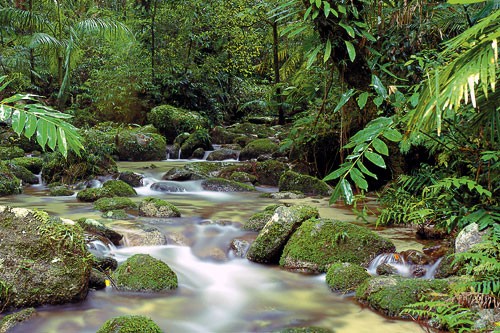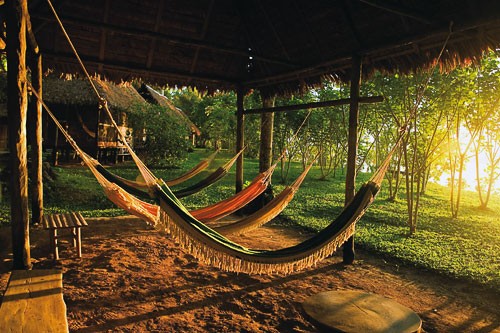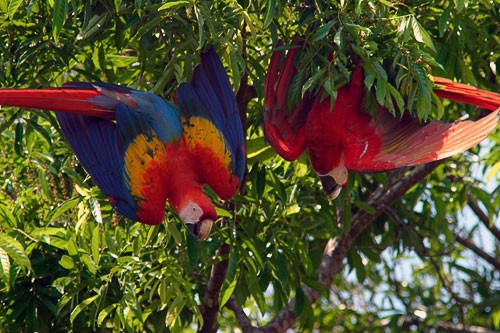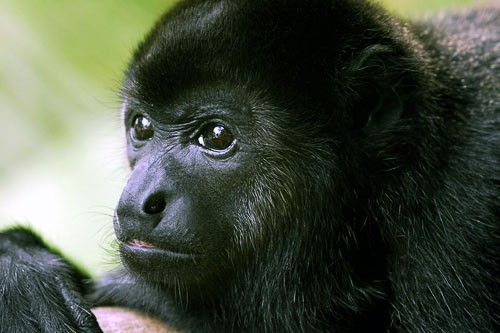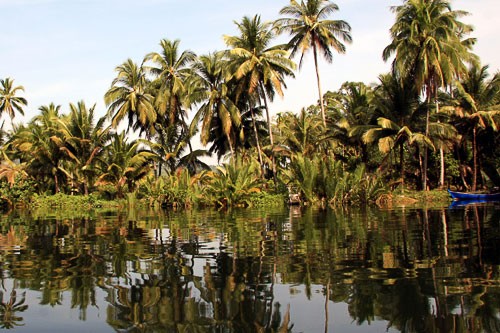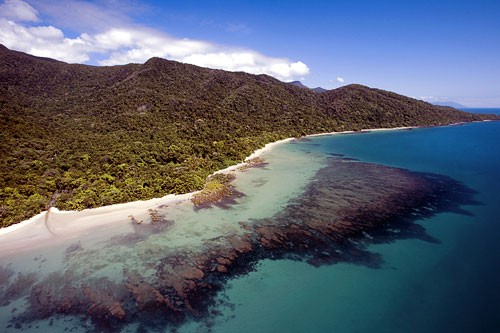Rainforest Resorts for Honeymooners and Romantics
By
Really Get Away from it All
By Hillary Richard McNamara
Not that there's anything wrong with all-inclusive resorts, but a visit to one of the world's few remaining tropical rain forests might be the ultimate honeymoon. Roughly half of the earth's living species of plants and animals can be found in the 6 percent of land mass that comprises rain forests globally.
Advances in eco-tourism and sustainability mean travelers can experience these rare environments more in-depth than ever before -- and still spend the night in comfort. For those interested in wildlife, nature, and adventure, a rain forest getaway offers endless possibilities.
Photo Caption: The Daintree Rainforest in Queensland, Australia.
Not that there's anything wrong with all-inclusive resorts, but a visit to one of the world's few remaining tropical rain forests might be the ultimate honeymoon. Roughly half of the earth's living species of plants and animals can be found in the 6 percent of land mass that comprises rain forests globally.
Advances in eco-tourism and sustainability mean travelers can experience these rare environments more in-depth than ever before -- and still spend the night in comfort. For those interested in wildlife, nature, and adventure, a rain forest getaway offers endless possibilities.
Photo Caption: The Daintree Rainforest in Queensland, Australia.
Peru
What: Three ecosystems converge within the Tambopata National Reserve in southern Peru -- the Amazonian plain, the Andean foothills, and the Pampas slopes. The reserve's 11 types of forests make it one of the most diverse ecological areas on the planet, and its nearly 680,000 acres are home to 13 endangered species, almost 575 species of birds, 1,200 species of butterflies, and 169 species of mammals.
Where: Tambopata is in the southeastern part of Peru, near the Bolivian border. The reserve, which borders Bajuaja-Sonene National Park, is 404 miles northeast of Cuzco and 23 miles southwest of Puerto Maldonado.
How To Get There: International flights arrive at Lima International Airport (formally called Jorge Chávez International Airport). From there, it's less than two hours on a domestic airline (like LAN Peru or Star Peru) to Puerto Maldonado International Airport (officially called Padre Aldamiz International Airport). The best way to access the heart of Tambopata Reserve is by boat down the Madre de Dios or Tambopata Rivers. The road from Puerto Maldonado to Cuzco runs along the northern edge of the park.
When: While Peru has a few different climates, its southern Amazon area stays consistently hot, damp, and humid. The best time to visit is during the driest months (May through October). It rains regularly throughout the year, but mosquitoes and overflowing rivers can be a problem during the wet season.
Price: Guests who stay at Inkaterra Reserva Amazonica travel through Puerto Maldonado town, visit Inkaterra Butterfly House, and take a boat down the Madre de Dios River in the Amazon Basin -- all before arriving at their lodge. Inkaterra Reserva Amazonica, which is adjacent to Tambopata National Reserve, boasts one of South America's largest canopy walks -- seven hanging bridges over 100 feet high. Rooms start at $550 per night.
More Info: Inkaterra Reserva Amazonica (www.inkaterra.com); Tambopata Tourism (www.tambopata.com); LAN Peru Airlines (www.lan.com); Star Peru (www.starperu.com)
Photo Caption: Hammocks outside a lodge on the Madre de Dios River in Peru's Tambopata National Reserve.
Where: Tambopata is in the southeastern part of Peru, near the Bolivian border. The reserve, which borders Bajuaja-Sonene National Park, is 404 miles northeast of Cuzco and 23 miles southwest of Puerto Maldonado.
How To Get There: International flights arrive at Lima International Airport (formally called Jorge Chávez International Airport). From there, it's less than two hours on a domestic airline (like LAN Peru or Star Peru) to Puerto Maldonado International Airport (officially called Padre Aldamiz International Airport). The best way to access the heart of Tambopata Reserve is by boat down the Madre de Dios or Tambopata Rivers. The road from Puerto Maldonado to Cuzco runs along the northern edge of the park.
When: While Peru has a few different climates, its southern Amazon area stays consistently hot, damp, and humid. The best time to visit is during the driest months (May through October). It rains regularly throughout the year, but mosquitoes and overflowing rivers can be a problem during the wet season.
Price: Guests who stay at Inkaterra Reserva Amazonica travel through Puerto Maldonado town, visit Inkaterra Butterfly House, and take a boat down the Madre de Dios River in the Amazon Basin -- all before arriving at their lodge. Inkaterra Reserva Amazonica, which is adjacent to Tambopata National Reserve, boasts one of South America's largest canopy walks -- seven hanging bridges over 100 feet high. Rooms start at $550 per night.
More Info: Inkaterra Reserva Amazonica (www.inkaterra.com); Tambopata Tourism (www.tambopata.com); LAN Peru Airlines (www.lan.com); Star Peru (www.starperu.com)
Photo Caption: Hammocks outside a lodge on the Madre de Dios River in Peru's Tambopata National Reserve.
Costa Rica
What: Corcovado National Park is widely considered to be the crème de la crème of the Costa Rican rain forest because of its unusual variety of flora and fauna. The park sustains a rare large area of lowland tropical rain forest -- meaning its original biodiversity is still intact. Visitors can see everything from jaguars (quickly becoming sparse in Central America) to sloths and bull sharks in Corcovado's 164 square miles.
Where: Corcovado National Park is on the Oso Peninsula in southwest Costa Rica.
How To Get There: The largest town near Corcovado is Puerto Jimenez. It's an eight-hour drive from San José city, or a one hour direct flight from San Jose (Juan Santamaría) International Airport. Air travel is recommended, since road conditions can vary drastically throughout Costa Rica.
When: The dry season runs from December through April. The best months to visit during the wet season (also called the "green season") are May, June, November, and early December.
Price: Stay at Lapa Rios, an upscale eco-lodge overlooking acres of preserved rain forest. Private bungalows are available for $380 (single occupancy) or $280 (double occupancy) during the green season.
More Info: Costa Rica Tourism Board (www.visitcostarica.com); Lapa Rios Ecolodge (www.laparios.com); Nature Air (www.natureair.com); AMBICOR (www.corcovado.org)
Photo Caption: Two scarlet macaws hanging upside down in a tree in Corcovado National Park.
Where: Corcovado National Park is on the Oso Peninsula in southwest Costa Rica.
How To Get There: The largest town near Corcovado is Puerto Jimenez. It's an eight-hour drive from San José city, or a one hour direct flight from San Jose (Juan Santamaría) International Airport. Air travel is recommended, since road conditions can vary drastically throughout Costa Rica.
When: The dry season runs from December through April. The best months to visit during the wet season (also called the "green season") are May, June, November, and early December.
Price: Stay at Lapa Rios, an upscale eco-lodge overlooking acres of preserved rain forest. Private bungalows are available for $380 (single occupancy) or $280 (double occupancy) during the green season.
More Info: Costa Rica Tourism Board (www.visitcostarica.com); Lapa Rios Ecolodge (www.laparios.com); Nature Air (www.natureair.com); AMBICOR (www.corcovado.org)
Photo Caption: Two scarlet macaws hanging upside down in a tree in Corcovado National Park.
Belize
What: Stretching from the foothills of the Maya Mountains to the Belize Barrier Reef, Southern Belize is truly off the beaten path. The Toledo District is the furthest south and the least developed, resulting in the most unspoiled rain forests in the country. Despite the estuaries, cave networks, Mayan ruins, sinkholes, waterfalls, and seven major parks and reserves, this area of Belize sees the least amount of tourists. The Toledo rain forests are home to wildlife such as fox, jaguar, deer, howler monkeys, tropical birds, armadillo, and crocodiles.
Where: The Toledo District (capital: Punta Gorda) encompasses 1,795 square miles in southern Belize.
How To Get There: International flights arrive to Philip S.W. Goldson International Airport (10 miles outside Belize City). Domestic hour-long flights to Punta Gorda can be booked through either Tropic Air or Maya Island Air.
When: The dry season is shorter in southern Belize. It typically lasts from January to April, with April being the driest month. September and October see the highest levels of rainfall.
Price: Stay at Machaca Hill Rainforest Canopy Lodge in Punta Gorda, set on a private rain forest reserve in the Maya Mountain Marine Corridor and along the Rio Grande. Rates start at $460 per person (based on double occupancy) and include all meals, drinks, tours, activities, laundry facilities, and one spa treatment. The lodge closes annually in September and October.
More Info: Belize Tourism Board (www.travelbelize.org); Machaca Hill Rainforest Canopy Lodge (tel. 501/722-0050); Tropic Air (www.tropicair.com); Maya Island Air (www.mayaislandair.com)
Photo Caption: A howler monkey in the Toledo District of Belize.
Where: The Toledo District (capital: Punta Gorda) encompasses 1,795 square miles in southern Belize.
How To Get There: International flights arrive to Philip S.W. Goldson International Airport (10 miles outside Belize City). Domestic hour-long flights to Punta Gorda can be booked through either Tropic Air or Maya Island Air.
When: The dry season is shorter in southern Belize. It typically lasts from January to April, with April being the driest month. September and October see the highest levels of rainfall.
Price: Stay at Machaca Hill Rainforest Canopy Lodge in Punta Gorda, set on a private rain forest reserve in the Maya Mountain Marine Corridor and along the Rio Grande. Rates start at $460 per person (based on double occupancy) and include all meals, drinks, tours, activities, laundry facilities, and one spa treatment. The lodge closes annually in September and October.
More Info: Belize Tourism Board (www.travelbelize.org); Machaca Hill Rainforest Canopy Lodge (tel. 501/722-0050); Tropic Air (www.tropicair.com); Maya Island Air (www.mayaislandair.com)
Photo Caption: A howler monkey in the Toledo District of Belize.
Cambodia
What: The Cardamom Mountains are heralded as one of Southeast Asia's largest and most pristine virgin rain forests. Fourteen endangered and threatened species of mammals are believed to live in the Cardamom rain forest area, including the Asian elephant, Indochinese tiger, Javan rhinoceros, clouded leopard, and pileated gibbon.
Southwest Cambodia has largely been ignored as a tourist destination because of its recent history; the Cardamom Mountains were the final stronghold of the Khmer Rouge and have yet to be fully explored. As a result, the rain forest has remained completely untouched, a feat in country that has one of the worst deforestation rates in the world.
Where: The Cardamom Mountains span 3,861 square miles throughout western Cambodia and into southwestern Thailand.
How To Get There: International flights arrive at Suvarnabhumi International Airport in Bangkok. There are daily domestic hour-long flights on Bangkok Air to Trat, Thailand, which is about 65 miles from the Cambodian border. A public bus is available and taxis or shuttles can be booked through almost any hotel. Certain areas are only accessible by water taxi.
When: The Cambodian dry season goes from November to April, with November and January often considered the best times to visit. The rainy season runs from May to October. September and October are traditionally the wettest months of the year.
Price: Four Rivers Floating Eco-Lodge consists of secluded, luxury cabins floating on the Tatai River. Prices range from $172 to $275 per night.
More Info: Cambodia Tourism (www.tourismcambodia.com); Four Rivers Floating Eco-Lodge (www.ecolodges.asia); Bangkok Airways (www.bangkokair.com)
Photo Caption: The banks of the Tatai River in Cambodia's Cardamom Mountains.
Southwest Cambodia has largely been ignored as a tourist destination because of its recent history; the Cardamom Mountains were the final stronghold of the Khmer Rouge and have yet to be fully explored. As a result, the rain forest has remained completely untouched, a feat in country that has one of the worst deforestation rates in the world.
Where: The Cardamom Mountains span 3,861 square miles throughout western Cambodia and into southwestern Thailand.
How To Get There: International flights arrive at Suvarnabhumi International Airport in Bangkok. There are daily domestic hour-long flights on Bangkok Air to Trat, Thailand, which is about 65 miles from the Cambodian border. A public bus is available and taxis or shuttles can be booked through almost any hotel. Certain areas are only accessible by water taxi.
When: The Cambodian dry season goes from November to April, with November and January often considered the best times to visit. The rainy season runs from May to October. September and October are traditionally the wettest months of the year.
Price: Four Rivers Floating Eco-Lodge consists of secluded, luxury cabins floating on the Tatai River. Prices range from $172 to $275 per night.
More Info: Cambodia Tourism (www.tourismcambodia.com); Four Rivers Floating Eco-Lodge (www.ecolodges.asia); Bangkok Airways (www.bangkokair.com)
Photo Caption: The banks of the Tatai River in Cambodia's Cardamom Mountains.
Australia
What: Dating back 135 million years, the Daintree rain forest is believed to be the world's oldest. (The Amazon is around 55 million years old.) It's also one of the most accessible and tourist-friendly -- there are regular boat tours through the forest along the Daintree River, as well as a variety of bus tour companies covering the area. The best way to explore Daintree National Park's 138,000 acres is in a rental car and on foot. The paved road from Daintree town to Cape Tribulation provides scenic lookout points, tropical beaches, and a host of lodging options.
Daintree has some particularly unique flora and fauna, thanks to its long history and relative isolation. Visitors can see platypus, musky rat-kangaroos, swamp wallabies, flying fox, echidnas, blue-winged kookaburras, pythons, crocodiles, and more.
Where: Daintree National Park is in Northern Queensland, the most northeastern state on the Australian mainland. Daintree National Park is 1,117 miles from Brisbane, 73 miles from Cairns, and 39 miles from Port Douglas.
How: Cairns International Airport has direct connections with New Zealand, Guam, and throughout Asia. Visitors can also fly into Sydney International Airport and then take a three-hour flight to Cairns, or fly into Brisbane International Airport and take a two-hour flight. Daintree National Park is a two-hour drive from Cairns.
When: August to early November is the best time to visit, but travelers should watch out for box jellyfish once November arrives. December to March is the wet season. Because cars and travelers need to cross the Daintree River on a ferry in order to get to the heart of the national park, a one-day buffer is recommended during the wet season. Intense flooding can stop river crossings and trap vehicles.
Price: Stay in a secluded rainforest banyan (house) at Daintree Eco Lodge and Spa in Daintree town, where you can experience the seclusion of camping in the rainforest without sacrificing any amenities. Aboriginal culture guides lead informational rainforest hikes, explaining Daintree's cultural and environmental significance. Rooms start at $365.
More Info: Tourism Australia (www.australia.com); Tourism Daintree Coast (www.daintreerainforest.com); Daintree Eco Lodge and Spa (www.daintree-ecolodge.com.au)
Photo Caption: Cape Tribulation in Daintree National Park.
Daintree has some particularly unique flora and fauna, thanks to its long history and relative isolation. Visitors can see platypus, musky rat-kangaroos, swamp wallabies, flying fox, echidnas, blue-winged kookaburras, pythons, crocodiles, and more.
Where: Daintree National Park is in Northern Queensland, the most northeastern state on the Australian mainland. Daintree National Park is 1,117 miles from Brisbane, 73 miles from Cairns, and 39 miles from Port Douglas.
How: Cairns International Airport has direct connections with New Zealand, Guam, and throughout Asia. Visitors can also fly into Sydney International Airport and then take a three-hour flight to Cairns, or fly into Brisbane International Airport and take a two-hour flight. Daintree National Park is a two-hour drive from Cairns.
When: August to early November is the best time to visit, but travelers should watch out for box jellyfish once November arrives. December to March is the wet season. Because cars and travelers need to cross the Daintree River on a ferry in order to get to the heart of the national park, a one-day buffer is recommended during the wet season. Intense flooding can stop river crossings and trap vehicles.
Price: Stay in a secluded rainforest banyan (house) at Daintree Eco Lodge and Spa in Daintree town, where you can experience the seclusion of camping in the rainforest without sacrificing any amenities. Aboriginal culture guides lead informational rainforest hikes, explaining Daintree's cultural and environmental significance. Rooms start at $365.
More Info: Tourism Australia (www.australia.com); Tourism Daintree Coast (www.daintreerainforest.com); Daintree Eco Lodge and Spa (www.daintree-ecolodge.com.au)
Photo Caption: Cape Tribulation in Daintree National Park.





